The centerpiece to the Battle of Spotsylvania Courthouse was Hancock’s assault on the Mule Shoe in the early morning hours of May 12th. This assault initially exceeded even the most optimistic Federal expectations, and came close to a defeat of unprecedented proportions for Robert E. Lee’s army. One of the most common misconceptions about the battle on May 12th is that the federal success was a result of a rare blunder by Lee. According to the myth all the Confederate artillery had been withdrawn from the Mule Shoe on Lee’s order during the afternoon of the 11th. While there is some truth in this it fails to tell the entire story. In this, the third and final part of our article, we illustrate that this was far from the case. We discuss the Confederate artillery positions around the West Angle and their fate. Finally we discuss whether this was the key factor in the debacle that took place on the morning of the 12th.
The second part of the article ended with the Confederate defenders along the lines of the Mule Shoe having been alerted that something was going on in the woods and fields out in front of their lines. General Johnson himself had walked along the line meeting with his commanders. Commanders were informed to increase the number of men on guard and to be on the alert.
It was just before dawn when as was the custom, those Confederates who had been spared the tedium of guard duty, rose from their resting places for the evening. All along the trenches around the salient, sore tired men were stretching, trying to shake off the dampness, perhaps answering a call of nature, or trying to prepare a cup of ersatz coffee when they were alerted by a quick smattering of firing out in the direction of the Landrum House. (1) Stopping as quickly as it started the defenders hardly found time to enjoy the ensuing quiet. Soon the comforting silence was broken by the unmistakable sounds made by a large body of men moving and apparently in their direction. Ground fog and a misting rain cut visibility for some time and helped to confuse the direction of the noise. Soon enough the silence was broken by the cheers from apparently thousands of men, and to these veterans the origin was unmistakably Federal. (2) Soon enough the advancing Federals became visible, and the defenders beheld an awe-inspiring sight. The entire field in front of their works, or at least that part which was visible, seemed to be covered with line after line of advancing Federals.
What they were seeing was the direct result of Upton’s near success at Dole’s Salient the evening of the 10th. There twelve regiments had quickly broken through the fortified line along the right of Robert Rodes division. Unfortunately for the Federals they failed to reinforce the success. At the same time the Confederates quickly sealed off the breakthrough and started to drive Upton’s men back. While not completely successful, Upton, realizing he couldn’t hang on, ordered his survivors back to their start line.
Grant always aggressive, recognizing how close Upton had come to success, decided to try again. This time however he would attack with an entire army corps. It appeared that the most favorable point for an attack would be the bulge in the Confederate lines to the left of where Upton had struck the line. So on the night of the 11th, the entire Federal Second Corps, under Winfield Scott Hancock, was moved from the Federal right to the fields around the Brown house. There they waited miserably in the rain for the orders to move out to the attack.
Hancock decided to align his four divisions into a formation with a two division front. The division of Brig. Gen David B. Birney would be in the lead on the on the right and that of Brig. Gen. Francis Barlow on the left. These would be followed by a second line with the division of Brig. Gen. John Gibbon on the left, and Brig. Gen. Gershom Mott on the right. Each division commander was allowed to form his men as he saw fit.
Scheduled to step off at 4:30 AM, Hancock chose to delay the attack for 10 minutes because of a lack of visibility. But finally the orders were given and the men stepped off in the direction of the Confederate lines. They had only the sketchiest intelligence on where those lines were, so they were almost as surprised as the Confederates when they struck the picket line near the Landrum House. Those pickets, because of the visibility and federal numbers could barely put up any resistance before Hancock’s juggernaut rolled over them.
Because the Federals didn’t have a great deal of information about the Confederate position they actually guided too far to the left. Some of Barlows men actually missed the apex and passed across the front of the northern leg of the salient. Birney’s right, which evidently lagged Barlow, did not extend as far as the West Angle.
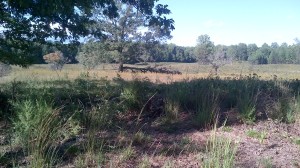
Looking out from the East Angle over the ground that Barlow’s right and Birney’s left would have advanced over.
From their position at the West Angle it seemed obvious to Capt. Carrington and his men that none of those Federals were attacking them directly. Rather their route of approach would strike the Confederate line several hundred yards to the right. There between the West and East Angles, they could see the familiar sight of the Confederate infantry calmly hurrying to get ready to receive the attack. While no enemy was yet visible in front of this section of the line, a few of the skirmishers of the Stonewall Brigade began to appear, hastily making their way back to the safety of the main line.
Suddenly from off in the distance, apparently beyond the East Angle came several cannon shots, apparently canister, and a brief flurry of musketry before quiet resumed. (3) Barlow’s men who were passing along the northern face had been initially checked by the Confederates along that leg of the Mule Shoe. Closer to them those Federals who were crossing the field to the right were only intermittently visible as they appeared and disappeared due to the folds of the ground. (4)
The men of Carrington’s battery and the Stonewall Brigade could only watch as the Federals reached the abatis and began to tear their way through it. Everybody watching, attacker and defender alike knew that this was the moment when the defenders would open with a murderous fire of artillery and musketry. But it didn’t happen that way. Yes they fired but the fire was far from being what was expected. (5) Because there were so few defenders, some thought that the lack of firepower was because the defenders powder was wet. (6) But realizing that they had a chance, the attackers redoubled their efforts and quickly broke through the abatis and started toward the main line of works. Of course the rest of the artillerymen at Carrington’s rear section and Tanner’s battery couldn’t see any of this. Being on the reverse slope behind the West Angle they couldn’t see anything in front of the line.
Those Federals who found themselves in front of the apex received a single canister round from the first gun of Willie Carter’s battery to reach its assigned position. Others of Barlow’s men broke through to the left of the apex, and quickly looped around behind the line and trapped the defenders in their positions, including the rest of Carter’s battery. Montgomery’s battery waiting for Carter to clear the way was caught in column and overrun. Some of the North Carolinian’s from Steuart’s brigade seeing this shot down the horses so as to impede the removal of the guns.
As they neared the line Barlow’s and Birney’s men had begun to diverge from each other. Seeing the opening in the ranks caused by Barlow’s men moving left in the line ahead of them Brig. Gen. Robert McAllister, commanding a brigade in Tyler’s division, accelerated his command and hit the Confederate line further to the their right. (7) Evidently still ahead of Birney’s men, they turned to their right they began to quickly roll up the line as they moved toward the West Angle.
As the Federals lines were breaking though in the area toward the East Angle there was little the men of the battery or the Stonewall Brigade could do to help their comrades. Gen. Walker, commander of the Stonewall Brigade, took a stand at the foot of the large Oak Tree just to the left of Sgt. Maj. Davis gun. (8) From his position he could see that the Federals had quickly broken the line along the front of the Louisiana and Witcher’s Brigades. He was constantly watching the progress of the Federals, alternately glancing to the front and to the right rear. Soon he ordered that the two guns in the main line be trained to the right as far as possible, and that they shell the woods in the right front. To add to the problem of observing the fire the humidity in the air caused the powder smoke to lay close to the ground. This added to the mist made all objects indistinct and adjusting the fall of shot virtually impossible. In addition because of a ravine out front the closest Federals had entirely disappeared from view. Only a few rounds were fired before Gen. Walker commanded the men to cease-fire saying “there is no enemy in reach that way”. (9) He then got down and proceeded to the right of his brigade to try to organize the defense.
From their positions in the front line, after the Federals had disappeared from view Carrington and his men had difficulty understanding the situation. Sgt. Maj. Wilbur Fiske Davis thought when one wild cheer was made, “that it was our men driving the enemy back – and we threw up our hats and hollered, too.” (10) “ I was under the impression that our infantry had repulsed the Yankees in our front and remember that one of our detachment, named George Wood, joined me in cheering, both of us waving our hats, or what was left of them.” (11)
To the men of Tanner’s battery the situation was even more unclear. From their position they could see nothing of the battle. Some firing was still going on, as well as cheering which they assumed was being done by the Federals. It appeared that the enemy had quickly broken the line, but all they could see and hear was an unclear scene of confusion.
As the Confederates around the West Angle were trying to grasp the situation word was passed along the line that artillery was coming up to support the line to the right. (12) While good news, it wasn’t going to help them with the Federals coming their way. About this time, frustrated by the inaction and inability to take part in the fight to the right, Sgt. Maj. Davis and his men decided to shell the woods to the right front again. The sights and sounds told them that the battle was swinging around to the right and rear away from them. So even though they couldn’t see the enemy they hoped to do some damage. Besides, the wheels of the guns were sunk into the ground, and without horses there was no way to withdraw them. By this time the gunner, Archie Houston, had been shot so Sgt. Maj. Davis had to act as gunner.
It didn’t take long for the men to exhaust the remaining ammunition in the one chest they had at the gun. Without any way to fight on they got back under the shelter of the traverses and waited for orders.. With the approach of the Federals the men of the battery found themselves in the midst of a crossfire. Not only were the Federals firing at the defenders and those fleeing up the line, but about this time Confederate infantry further to the left began firing up the line, endangering their comrades. This further complicated the defense as men sought cover and frantically waved and gestured in an attempt to stop the fire. Even the pits and traverses were no guarantee of safety. While they did offer some protection from the bullets crisscrossing along the line, they were ineffective against the fire which seemed to be coming thru the woods as the Federals worked around to the right and rear. One of Davis’s crew, Johnny Halbeck, was shot by friendly fire as he reached around the traverse and waved his hat to get his friends to cease-fire.
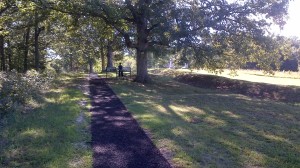
View the Federal troops would have had as they advanced up the inside of the works toward the West Angle.
In the middle of the chaos Confederate troops could be seen through the mist and haze falling back up the line of works trying to form a line as the Federals approached. While some of the troops were stubbornly falling back up the line of works trying to form a line the Stonewall Brigade began to disintegrate. According to one of Carrington’s men “The men going by in groups firing occasionally – but without any command and seeing they were flanked and in danger of being cut off”.
It was only a few minutes before General Walker who was retreating back up the line of the Stonewall Brigade met Carrington near Sgt. Maj. Davis’s gun. He excitedly and appealed to the Captain to provide some support for his men. Gesturing as he spoke he hurriedly told Carrington that the Federals were in his rear he asked, “Carrington, can’t you help my men with your battery?” Because Walkers men were between the guns and the Federals, Carrington could see that the situation was hopeless and could only reply “General, it is difficult to get these guns out here in the woods, and if I could see where your men are, they are between me and the enemy, and if I attempted to use canister, it would be more destructive to them than to the enemy;” (13)
By now the remnants of the right-wing of the Stonewall Brigade still fighting had been driven back almost to Sgt. Maj. Fiske Davis Napoleon. (14) Gen. Walker and Capt. Carrington were still together when General Walker was struck in the arm by a minie ball. The impact spun him around and evidently produced great shock and pain. (15) Seeing that he was wounded, men nearby immediately rushed to the Generals aid. Collecting himself the General called one of Sgt. Maj. Davis’s gun crew, Private Walter Preston, to him and ordered him to take a message to Colonel Funk, the ranking Colonel in the brigade. He ordered Preston to inform the Colonel that he had been wounded and would have to leave the field. Funk was ordered to take command of the brigade and continue the defense. (16) Evidently in the circumstances there were no specific instructions given as to what actions Col. Funk was to take. Unfortunately Preston was also wounded in the arm before he could deliver the General’s message. (17) As a result there would be no coordination among the units of the Brigade.
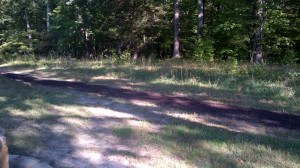
Looking from the trenches at the West Angle to the rear. Notice how the ground falls off, the Federals could sweep down the interior of the works unobserved.
Meanwhile the men at the two rear guns could see little if any of what was happening in front of the works. However they could hear the guns in the line firing as well as the infantry fighting working its way toward them through the woods. The Federals having made their breakthrough were expanding the breakthrough not only down the line but into the interior of the salient. With the withdrawal of Gordon’s men from the second line earlier that morning there was no organized unit between the rear section, Tanners battery and the Federals. Without infantry support they would inevitably be outflanked. The prudent thing to do would be to withdraw the guns to a more defensible position while there was still time. However without horses there was no way to remove them from the position in the face of the enemy. So both of Carrington’s guns were manhandled out of the pits and reversed to aim in the direction of the sound of battle which was obviously coming their way.
As soon as a target became visible these guns opened fire. In their haste to get the guns into a firing position the crews had overlooked some basics. At the first shot one of the guns recoiled back into the ditch. From that position it couldn’t be brought to bear on the Federals. realizing that it could not be gotten out before the Federals overran it the crew abandoned and fled toward safety. The crew of the other gun had evidently been a bit more careful in their preparation. They claimed that they were able to fire about a dozen shots before it had to be abandoned. Even so, it didn’t take the men at the guns long to realize that the situation was critical. According to one of them “They (the Federals) had flanked us and were coming down on us on the right and in the rear, they had gotten nearly to the works on the left and front where the other two guns were”. Only a few Confederate infantrymen continued to fight on, most of the Stonewall Brigade had collapsed. Those who weren’t captured escaping the best way they could. One of Carrington’s gunners claimed that at the time the rear guns were abandoned he “looked up and saw two Yankee flags waving on our works twenty yards above me and the woods full of Yankees”. (16) Even so it appears that the two rear guns were abandoned before those in the main line.
By now it was apparent to Captain Carrington that he and his men would soon be surrounded Most of the Stonewall Brigade had given way, and the enemy had almost reached the guns in the main line. Even though no Federals had appeared in front of the main line at this point there were plenty elsewhere. A line of Federals was advancing along the inside of the works, while others were working their way thru the woods further inside the salient The horses which were the only practical way to withdraw the guns still had not returned. (17) The infantry support was rapidly collapsing and breaking around them, this combined with the proximity of the Federals made it obvious that there was no way to save the guns. So Carrington reluctantly ordered his men to leave the guns and save themselves if they could. Haven given the order he then attempted to get away himself. In the noise and confusion some of the men either did not hear the order, or didn’t realize the seriousness of the situation thinking that the Federals had been repulsed. Those that were able to get away did so by running up the breastworks and into the woods to the left. One of those who escaped was Private Corey Maupin, stationed at Sgt. Maj. Davis’s guns in the main line. He remembered that upon turning to his gun he saw the Federals within 30 yards and also coming up the inside of the works. Quickly assessing the situation, he left the gun and ran as fast as he could toward the left and hopefully safety. Jumping over a brush pile he didn’t stop running until he met some of Gordon’s men coming up in a counterattack. Later he would credit the fog as well as the size of the trees for his escape. His friend Private Woods along with the rest of the crew didn’t see the Federals in time and were captured at the gun. He described how “A line of infantry came along through the woods – within our breastworks, and captured us, we not seeing them nor they us until they were right at us. (18) We were double – quicked by our guards – (to save themselves) – across the breastworks and down the hill, through the woods to the right, passing a line of file closers, like a line of battle – passing also a four horse ambulance in which we were told was General Grant – until we were completely out of range, and then marched perhaps three miles. We (Carrington’s battery) were run over, the enemy coming along the top of the breastwork, from the right and also coming up along our rear of the breastwork from our right.”
As Captain Carrington was leaving his position one of his men told him that several of his men were at one of the guns and had not heard the order to retire. (19) This must have been Sgt. Maj. Davis and his crew. So he turned and started back to get them off to safety. Upon arriving at the abandoned left hand gun (20) in the main line he looked over the breastworks into the open field and saw a large number of Confederates heading towards the Federal lines. There were so many that he thought that they were charging the enemy. To him it was inconceivable that so many of their men had surrendered together. About this time word was whispered down the line of artillery being rushed up to the line to the right but this was quickly followed by the news of some disaster befalling the guns. Taking in the situation, Carrington found that the gun was loaded, lanyard in place ready to be fired. Also that several regiments of the enemy were approaching, to the left of the mass of Confederates, who he had thought were charging. It appeared that the Federals were attempting to flank the charging Confederates. And these Federals were within immediate range of the gun. Grabbing the lanyard he was in the process of pulling it off when he felt a tug on tail of his overcoat. Looking down he noticed one of his men named Bishop lying by the trail of the gun. He told the Captain to “look there!” Turning to his right he saw a Federal in a Colonel’s uniform pointing a cocked pistol at his head. Not realizing whether the man was a Federal or Confederate, Carrington turned quickly, taking the man by surprise, and knocked the mans pistol away while getting his own pistol on his assailant. The man coolly responded that “I could have killed you, and here are my men all around you”. Sure enough within twenty steps there were a number of Federals lying on the ground muskets cocked, and aimed at him. Evidently they had come up thru the woods without being noticed by Carrington. Given the situation discretion was the better part of valor, so Carrington surrendered to that officer.
Sometime in all of this confusion the four rifles of Tanner’s battery with their entire crews captured. The men were herded together with the rest of the prisoners of Johnson’s division and sent to the Federal rear. The guns also were run across the works and sent to a park near the Landrum House.
By now all the guns at the West Angle had been captured and there would be no further organized resistance in the area. The Federals had not captured this section of the line by frontal assault, but rather be sweeping up the interior of the salient. Despite the completeness of their success the Federals were unable to expand the breakthrough much further along this leg of the Salient. The infantry of Haye’s Louisiana Brigade, manning the trenches across the McCoull Lane from the West Angle, was able to evacuate the trenches with the relatively minor loss of 38 men captured. They fell back up the hill and along with Daniel’s North Carolinian’s, Rode’s right hand brigade, established a line perpendicular to the trenches on the crest of Dole’s Salient. Fortunately Gordon’s Brigades counterattacking into the interior of the salient provided cover for the right flank. Initially the only artillery support the defenders had from Asher Garber’s four guns of the Staunton Artillery, Cutshaw’s sole remaining battery. Seeing the Federals rolling up the line in his direction, Gen. Robert Rodes had taken action early on. Rather than wait for the horses to be returned he took immediate action. Capt. Garber was ordered to have his men manhandle the guns out of their pits, run them to the rear by hand, and prepare to support their comrades. As the survivors of Johnson’s division retreated up the hill and across the fields Garber was ordered open fire over the heads upon the Federals at the base of the hill.. About the time he opened fire Major Cutshaw arrived near the batteries position along with the horses, caissons and limbers for the entire battalion . (21) Additional units would expand this line and shortly a succession of brigade sized counterattacks would reclaim most of the territory which had been lost.
Despite the success of the infantry in recapturing much of the lost ground, none of the guns from the two batteries at the West Angle would be recovered by the Confederates. McAllister’s 1st Brigade of the 4th Division Second Corps claimed that they captured a battery of 8-10 guns between the first and second lines. The two most important trophies to a Civil War unit were the opponents artillery pieces and their flags. So important were these that rather than continuing to advance Gen. McAllister decided to safeguard the captured guns immediately. Orders were given to have all but two of the captured guns hauled across the works and taken back into the safety of the union lines. Only after the job of removing the guns across the works did he reorganize his men and advance to attack the second line. The remaining two guns were to be turned against their former owners. Fortunately for the Confederates, though the guns were loaded they could not find the implements to fire them. When the Confederate counterattacks threatened McAllister’s position he fell back and joined a line running at an angle away from the original Confederate line. Before he pulled back however the remaining two guns were moved back to the Federal side of the lines. Thus in an indirect way the loss of the guns at the West Angle gave the Confederates a little more time to organize their defense. (22) Ultimately the Confederates were only able to retake the line as far as some lunettes behind the main line. (23)
Actual casualties in the artillery were surprisingly light, although perhaps indicative of the hopeless situation the batteries found themselves in. Carrington had three men killed, one of whom may have been by “friendly” fire. In addition two of the men from Carrington’s battery were wounded that morning. Tanner’s battery had two men, one of them the batteries second in command, killed. They also had two men wounded. The majority of the men lost were taken prisoner, 38 in the Charlottesville battery, 23 in Tanner’s battery.
With these casualties not to mention all the guns, and a large quantity of equipment it’s not surprising that neither unit was reconstituted. The survivors as well as the remaining horses and equipment were dispersed to other batteries which had shortages. Many of these men would continue on until the end at Appomattox.
Along the eastern leg of the salient some of the guns from Page’s battalion, were recaptured before the Federals could remove them. At least two of these guns were placed in action by the infantry of Pegram’s Brigade and fought throughout the day. After the position along the West Angle front had at least been stabilised, Maj. Cutshaw and Capt. Garber along with some of Garber’s men to man these guns. They fought them the rest of the day before returning to Garber’s battery that evening.
Later in the day those guns along with some of the recaptured caissons were removed from the trenches sent to the rear in preparation for their removal from the field. Left near the McCoull Branch they were left unattended most of the day. That night Maj. R. C. M. Page was ordered to take a detail and recover these guns and caissons prior to the infantry abandoning the Salient. However through a series of mishaps they were not recovered before the detail sent for that purpose gave up the task.
While the events prior to the Federals breaking the line are straightforward the fight within the Mule Shoe is not. As soon as the Federal troops broke over the works around the East Angle command and control began to break down. Unit cohesion was lost and units became intermingled due to not only Confederate resistance but the tendency of some men to stop and gather souvenirs, or plunder. Collecting the large number of prisoners and equipment then directing them to the rear didn’t help matters. As evidence of this confusion one only need look at the fate of the flags of the two batteries. The flag of Carrington’s battery was captured by Pvt. Michael Burke of Company D of the 125th New York. His regiment was part of the 3rd Brigade of Barlow’s Division, commanded by Col. Hiram R. Brown. (24)
Tanner’s battery flag was captured by the 19th Massachusetts Regiment of the 1st Brigade of Gibbon’s Division. This Brigade was commanded by Brigadier General Alexander S. Webb. (25) Gibbons Division had been on the left of the second line of Hancock’s charge. Thus his men would have been the furthest from Tanner’s battery of all the Federals. We can only presume that these men had circled to the right as they penetrated the Mule Shoe. But the 19th Massachusetts claimed that they captured approximately 400 Confederates who were crossing a field in their front, also that it was they who loaded the two Napoleons with whatever was available. While it is understandable that units would get mixed up in the salient, this claim is at odds with McAllisters. As to the claim of the prisoners, it seems likely that many of the Confederates attempting to escape from the area around the East Angle, or in the area behind the main line would have fled to the interior of the Salient. Thus Federal units penetrating the line could have cut them off.
Ever since the battle the actions of the Confederates that day have been scrutinized and debated. Most of this conjecture has been about the guns that returned to the lines, not those that stayed. But the questions remain unanswered. Could the Confederate artillery inside the Mule Shoe that morning have repelled the attack? Almost certainly not. While there were several factors which conspired against them, the lack of horses to move the guns, the dramatic weakening of the infantry at and between the East and West Angles, the fact that the positions of the remaining artillery were not designed to resist an attack from the right, and the wounding of General Walker, it probably made no difference. Once the Federals had broken thru the line and gained the interior of the salient there was no natural halt line short of the ones the Confederates actually did eventually use. These plateau at Doles Salient and the old abandoned line along the crest above the McCoull Branch.
So in short the battle played out as it did, most men doing the best they could under extraordinary circumstances.
Footnotes
(1) Federal records indicate exactly when Hancock’s men stepped off towards the Confederate lines. However no one knows how long it took them to actually cross the field and reach the line. Too many contradicting factors, weather, terrain, fear, excitement were at play for this author to make a reasonable guess. Confederate records are silent as to the time of the assault. Perhaps some industrial engineer could add some insight based upon his science.
The Confederate picket line was in a ravine approximately 1000 yards in front of the Salient.
(2) Federal commanders had cautioned their men not to cheer until the works were reached. However some of the less experienced troops mistook something, they called it an advance line, for the main line and raised a cheer prematurely alerting the defenders. In liklihood it was those that had missed the apex of the east Angle, crossed the original Confederate line, and passed down that face until fired on by reese’s battery.
(3) This would have been Reese’s battery, the Jeff Davis Artillery, at the extreme right of Johnson’s line. They repulsed those Federals who missed the apex of the East Angle and were passing down in front of the East leg of the Salient.
(4) The Federal assault did not hit the salient squarely. The left hand elements of Barlow’s Division evidently missed the apex, passed along the eastern leg and appeared in front of Reese’s salient. It was the center and right of Barlow that hit the apex at the East Angle and to its (Confederate) left. Birneys division had not struck the line when Barlow broke thru.
(5) Several observers remarked on the almost visible relief on the part of the attackers when they realized how weak the fire was. If it was two shots it couldn’t have been Willie Carter, commanding Page’s lead battery, as he only fired one round before being overrun.
(4) Gen. James Walker, commanding the Stonewall Brigade claimed in SHSP vol. that the defenders were disarmed by the dampness. That he heard the popping of primers from the Confederate lines. Significantly, there are no other sources on either side who mentioned it. In particular the Federals who, exposed as they were in the fields around the Brown House would have been most susceptable. One would not expect troops to have loaded weapons until just prior to the need. Both from a safety and practical aspect it likely wouldn’t have been done. No one would want to risk having a damp charge that would have to be pulled. And, standard procedure would have been to place a primer only on the weapon and fire it to clear the weapon. This could be quickly done by experianced troops.
(5) Robert McAllister
(6) Wilbur Fiske Davis – University of Virginia Alderman Library – An important statement by Davis. If as the author believes he is referring to THE large oak shot down, It locates the position of the confederate artillery on that fateful morning.
(7) Wilbur Fiske Davis – University of Virginia Alderman Library – These rounds, along with one by Willie Carter, were the only attempt by the Confederate artillery to support the fight for the East Angle.
(8) Wilbur Fiske Davis –
(9) Corey Maupin –
(10) James McDowell Carrington – University of Virginia Alderman Library- Daniels Collection. In the authors opinion the most provocative statement he has read about the events of May 12 is this one by Maj. Cutshaw to Capt. Carrington in 1905. At the time Cutshaw was reviewing and commenting on a newspaper article Carrington was writing. “Why only one battalion was ordered back after 12 o’clock at night and why they did not go there until the enemy was just about to break over the works it is difficult to say. There are points which could be discussed if we were together that might account for this, but it is not possible to clear it up in the brief comment on the account as you have it. “ To my knowledge Cutshaw never clarified what it was he could have commented on. By this time most of those who could have been involved in the matter were deceased.
(11) James McDowell Carrington – University of Virginia Alderman Library- Daniels Collection.
(12) James McDowell Carrington – University of Virginia Alderman Library- Daniels Collection.
(13) Wilbur Fiske Davis – University of Virginia Alderman Library
(14) There is no evidence that the individual regiments of the Stonewall Brigade cooperated or attempted to form a line perpendicular to the works. This is certainly understandable given the speed and depth of the Federal breakthrough and the wounding of General Walker.
(15). James McD. Carrington: General Walker on several occasions afterwards when in Congress here in Washington talked with me about it, and asked me if I remembered whether he fell, stating that the shock was so great that I could give him no information on the subject, except such as I have written above.
(16) Wilbur Fiske Davis – In the words of Davis ” It turned out that Preston was himself shot down with the loss of an arm – before finding Funk. I knew him in 1890 in Culpeper, where he was teaching.
(17) This would imply that the Federals had at least nearly reached the guns in the main line. However if as Carrington says he was at one of the guns in the main line when captured by Federals that had come up behind them maybe the rear guns were abandoned first.
(18) Wilbur Fiske Davis – University of Virginia Alderman Library – All indications are that at the time the battery was captured the Federals had not actually assaulted the West Angle frontally. In fact it is doubtful that Birney’s line extended that far to the right. He probably struck the line near the right flank of the Stonewall Brigade.
(19) Without these horses it wouldn’t have been possible to move the guns for any distance through the woods and obstructions. According to Maj. Cutshaw these horses only arrived at Garber’s position after the Federals were assaulting Rode’s impromptu line at Dole’s Salient. This would have been well after daylight, a time which would even without a Federal attack have exposed them to sharpshooters. Surely Johnson would have given Cutshaw a time to have them back to the batteries.
(20) James McDowell Carrington – University of Virginia Alderman Library- Daniels Collection. Evidently Sgt. Maj. Davis’s crew. They seem to be the only group captured at the gun.
(21) Presumably Sgt. Maj. Davis and his crew.
(20) James McDowell Carrington – University of Virginia Alderman Library- Daniels Collection. – the authors reason for saying the lefthand gun is that Davis and his men were captured at their gun. It doesn’t stand to reason that the Federals would have abandoned that gun before Carrington could have reached it. He could not have seen the approaching federals from one of the rear guns.
(21) While it is possible that Cutshaw followed Page from the camp on the Trigg Farm, it doesn’t answer the basic question. When was Cutshaw supposed to have the horses back at the guns? It is inconceiveable thatwhen he gave permission for the horses to be taken to the rear, Cutshaw and Johnson didnt agree on a time for them to be back in position. We know when the Yanks stepped off to the attack it was light enough for them to see,
(22) There are only two possibilities if McAllisters account is accurate. First that these were guns from Page’s battalion. Secondly, and more likely that they were the guns of Carrington’s and Tanners batteries. The evidence here is fairly conclusive. He claims that after sending the guns across the works they moved forward and encountered a second line. The second line did not extend but a few yards past the west angle. Secondly he says that the Confederates recaptured the line up to his right. If he had been in the area of Page’s guns they would have retaken works to his left. He also mentioned that a new line was formed at an obtuse angle to stop the Confederates progress on the right. Also that the large tree shot down was in their immediate front.
(23) These lunettes marked the limit of the Confederates advance back up the works to the right. They were described by some of the Confederate infantryman who fought there as caisson lunettes. From examining the ground behind the mainline between the East and West Angles, I believe that they were referring to the gun pits of Carrington’s two rear guns. Of course since this area has never been mapped as of 2012, it is possible that any lunnettes directly behind the line were obliterated by the CCC or construction of a now gone park road.
(24) Pvt. Burke was shot through the breast later in the day and killed.
(25) During the morning Webb would be wounded by a bullet which passed through the corner of his right eye and passed out of his ear. He would return to service later in the war.
(16) Wilbur Fiske Davis – In the words of Davis ” It turned out that Preston was himself shot down with the loss of an arm – before finding Funk. I knew him in 1890 in Culpeper, where he was teaching.
(38)

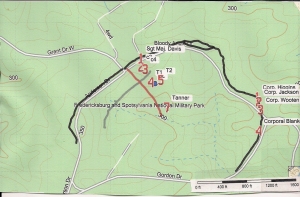
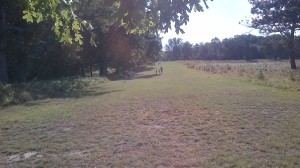
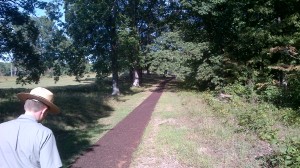
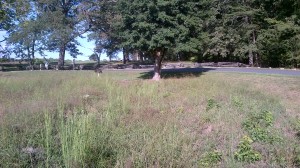
Thank you for your hard work on this. I have only been able to find one detailed account of the fighting here, that in Rhea’s book. This certainly makes things much clearer to me now.
LikeLike
Stephen
Thank you for the kind words. Have you read the late William (Bill) Matter’s book “If it takes all Summer”? That preceded Rhea’s book by several years. I may be partial as I consider Bill to have been a friend and mentor, I consider it at least the equal of Gordon’s book. Not as good a writer perhaps but maybe better in other areas.
I hope I have shown that the role of the artillery has been misunderstood for a long time.
Next will be kind of an overview article, followed by some things on other facets of the battle.
Thanks again.
Russ
LikeLike